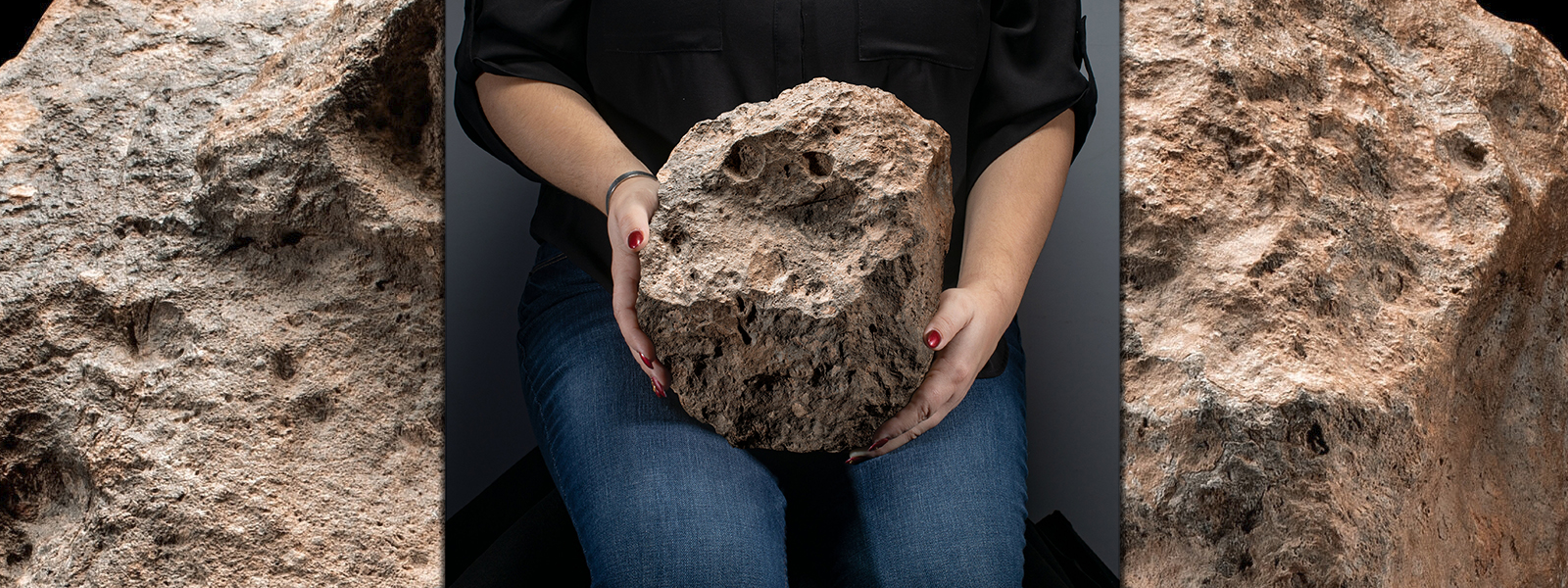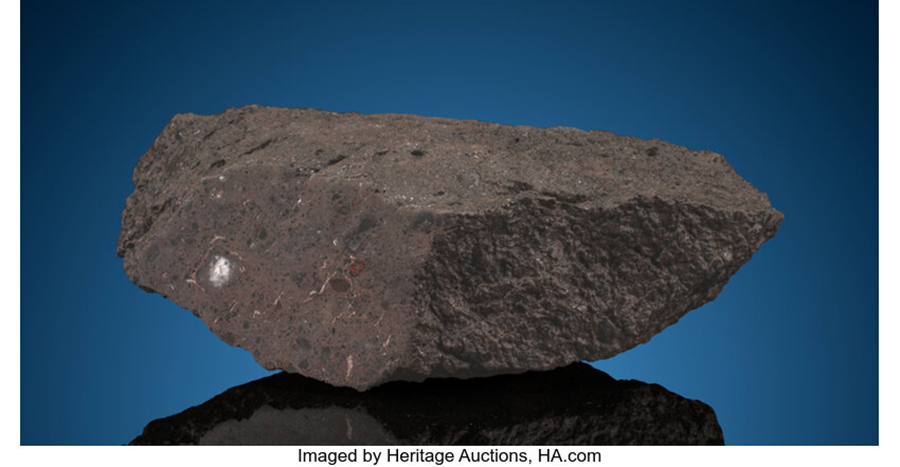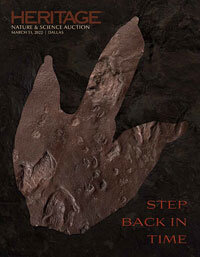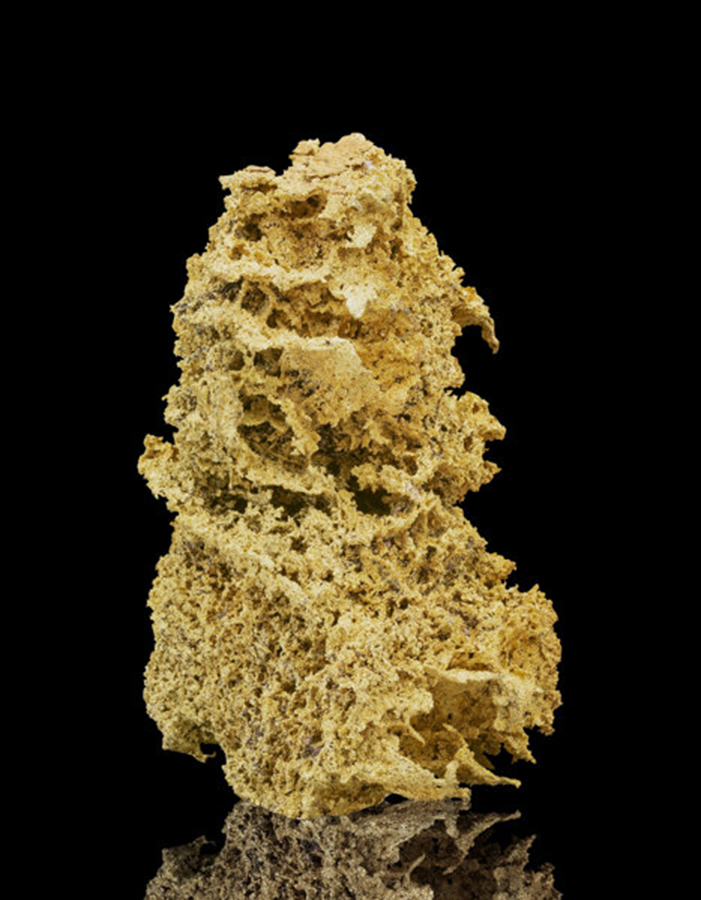JOINING THE MASSIVE PIECE OF THE MOON ARE CRYSTALLINE GOLD AND A 20-FOOT DINOSAUR TAIL AND VERTEBRAE SECTION
By Steve Lansdale
English writer Arthur C. Clarke famously called the moon “the first milestone on the road to the stars.” And on March 31, during Heritage’s Nature & Science Signature® Auction, one lucky bidder will take the initial step on that space odyssey when a massive NWA 15368 lunar meteorite crosses the auction block.
Found in 2021 by camel shepherds in the North African nation of Mali, the offered specimen is almost the size of a basketball and weighs nearly 17 kilograms (37.42 pounds), making it one of the largest lunar meteorites to be offered at auction.
“Lunar material on Earth is incredibly rare,” says Craig Kissick, Vice President of Nature & Science at Heritage. “It can be seen at NASA or in certain museums, but that is not the same as holding a piece in your hand. Sometimes a meteorite strikes the surface of the moon, compressing the material on the surface. That can break off and jettison from the moon’s surface. Very few of those happen to head this way and make it through Earth’s atmosphere, but that’s what happened in this case.”
Dustin Dickens, President of the Colorado Center for Meteoritic Studies, is the consignor of the specimen.
“The moon has always been a place of wonder for all of us,” Dickens says. “Every culture has told the story of the moon in their own way. It’s a collective cumulative story told and retold over millennia. Together in an ancient past we looked up as a planet to its guiding light and marveled at its tidal forces and predictive power. In these moments our inevitable journey began.
Lunar material on Earth is incredibly rare. It can be seen at NASA or in certain museums, but that is not the same as holding a piece in your hand.”
–Craig Kissick, Vice President of Nature & Science, Heritage Auctions
“As we return to the moon with NASA’s Artemis missions and study the pieces we have here on Earth, like NWA 15368, we contribute to this collective narrative. Together we take the next bold steps, looking to the moon again and setting our sights on a permanent staging ground for the human race to explore and study the solar system and beyond.”
As massive as the offered specimen is, when it comes to lunar meteorites, Dickens says substance is far more important than size.
“For me, size doesn’t mean anything,” he says. “It’s all about what it’s made of. Geochemically, it’s really clear that this is from the moon – there’s zero question. Now anybody, whether you’re 5 or 500, can look up, see the moon and say, ‘This is a piece of it.’”
The NWA meteorite is an otherworldly treasure but hardly the only out-of-this-world offering in the auction. Also available is a Tisserlitine 001 lunar meteorite. One of 67 meteorite lots in the auction, it was found in 2019, also in Mali. This specimen measures nearly 7.7 inches (19.5 centimeters) in length and weighs 2,096.8 grams (4.6 pounds). It features a sizable cut, polished window face on one edge, revealing a glimpse into its internal composition, and its kaleidoscope of brown hues differentiates it from other feldspathic breccia, many of which are stark black and white in tone.
NATURE & SCIENCE SIGNATURE® AUCTION 8129
March 31, 2023
Online: HA.com/8129a
INQUIRIES
Craig Kissick
214.409.1995
CraigK@HA.com
Other top meteorites include an NWA 13119 lunar meteorite end cut, a Park Forest meteorite and impact crater and an NWA 13038 Martian meteorite – main mass.
But not all the treasures in the auction came from the sky. Dubbed “The Hanging Gardens,” a stunning crystalline gold out of the famous Oriental Mine in Sierra County, California, measures 6.38 inches (16.20 centimeters) long and weighs 1,873.73 grams (60.23 troy ounces). Mined by the original owners of the mine in 1975, the collector-grade specimen features a complex growth with thousands of microcrystalline gold crystals with a delicate “leafy” appearance.
Few natural history collectibles can capture attention like dinosaur bones – partly because of the mystery surrounding the creatures that died off so long ago and partly because of the massive scale. Such is the case with a “mummified” Hadrosaurid dinosaur vertebrae and tail section, a gargantuan relic that stretches more than 20 feet (6 meters) in length.
Found in 1999 in Harding County, South Dakota – informally known as the “T. rex Capital of the World” – this spectacular fossil can be traced back to the Late Cretaceous period some 100-66 million years ago. The massive vertebral and tail section comes from a plant-eating Hadrosaur, and two things make the fossil remarkable: the presence of some of the creature’s tendons and extremely rare fossilized skin, a level and extent of “mummified” preservation that is virtually unheard of in such vertebrate fossils. In addition, the remains show possible scars or bite marks that could indicate the tail section was used in a defensive manner and could have been bitten by a T. rex in battle.
 STEVE LANSDALE is a staff writer at Intelligent Collector.
STEVE LANSDALE is a staff writer at Intelligent Collector.





